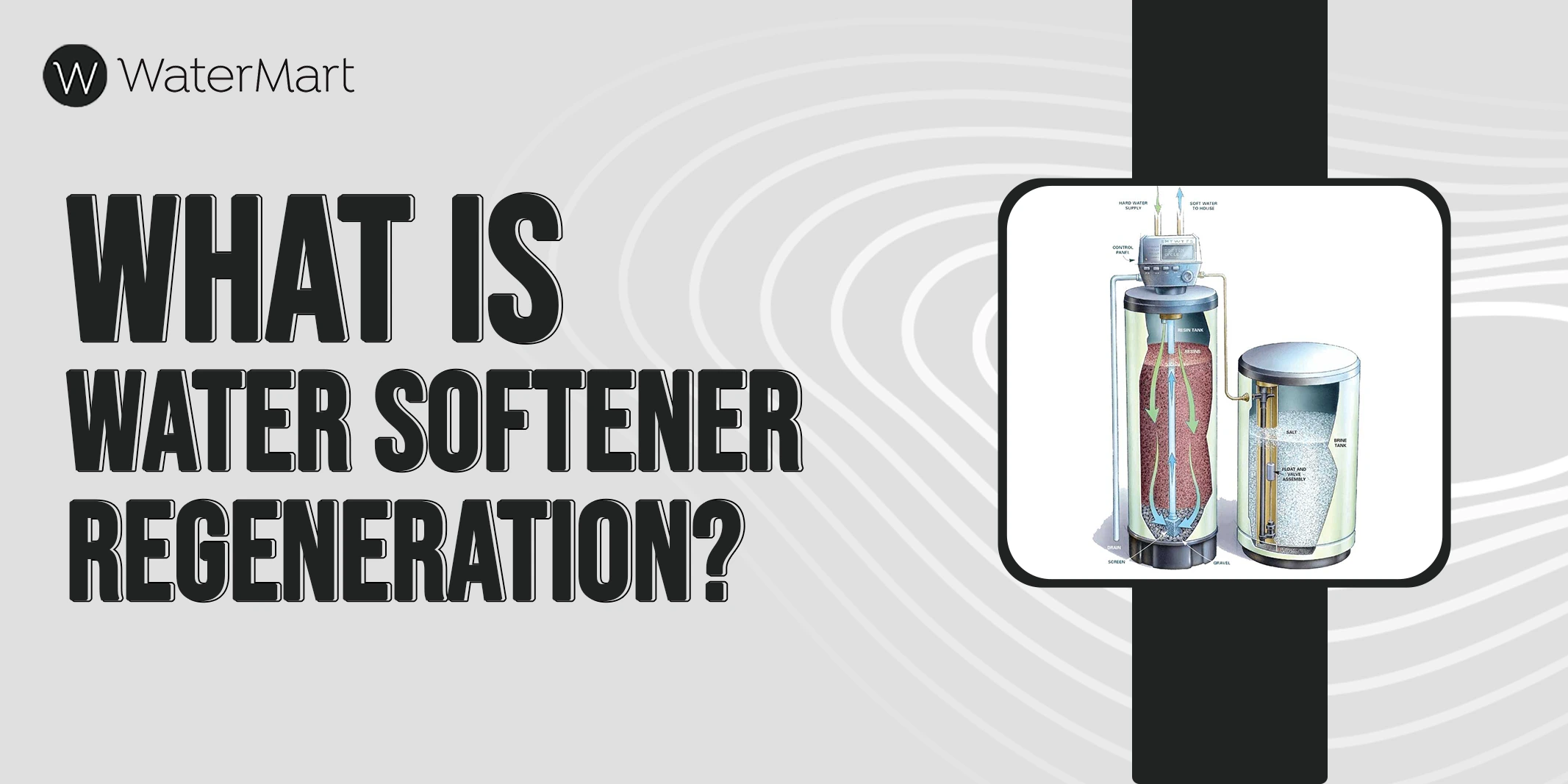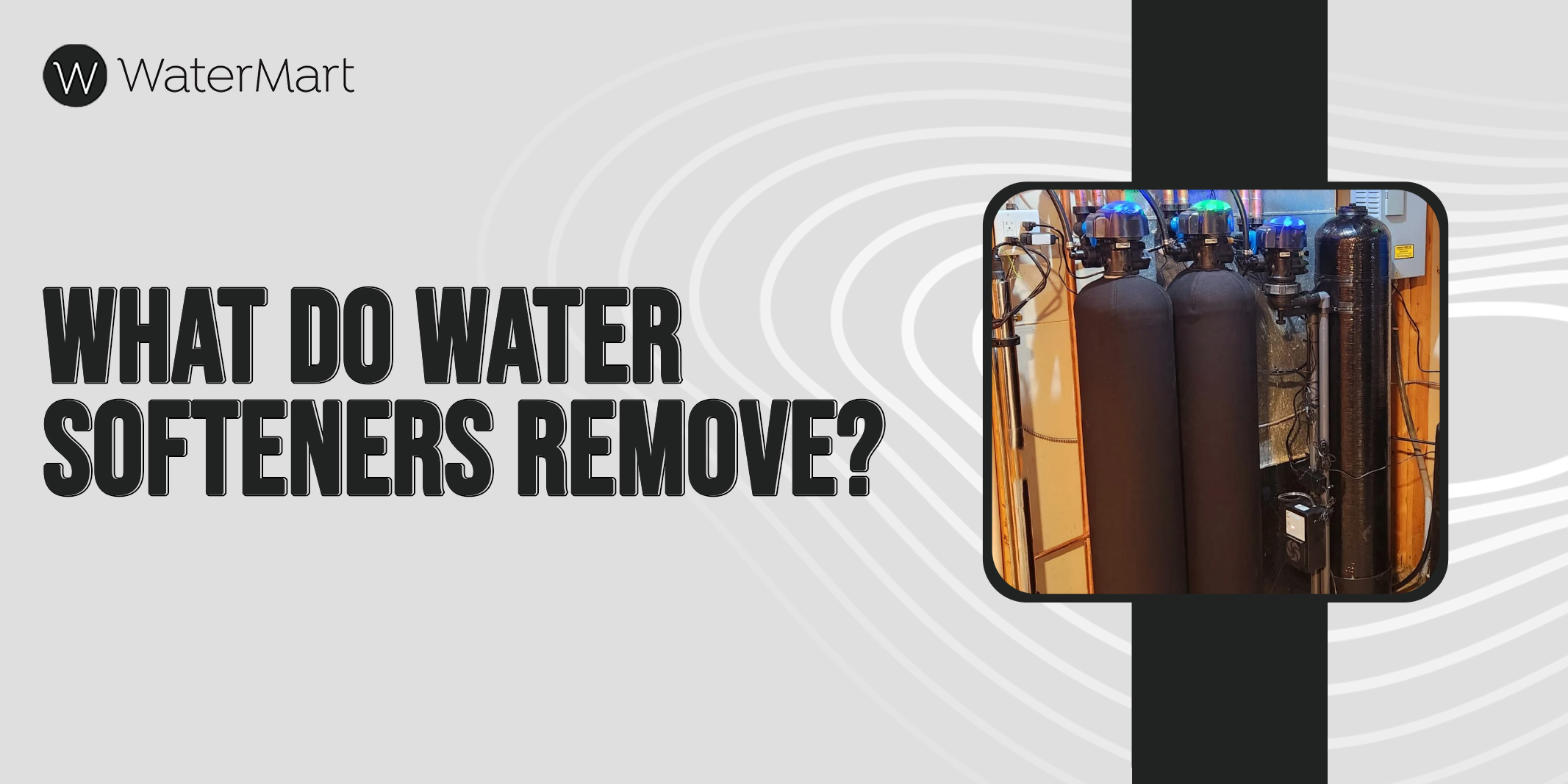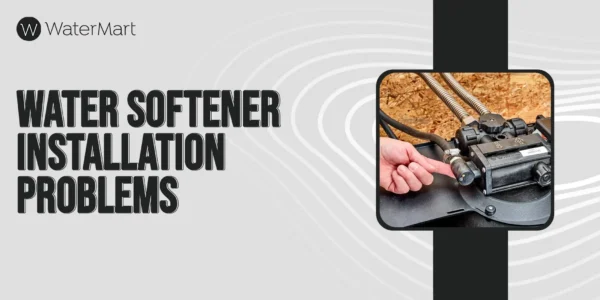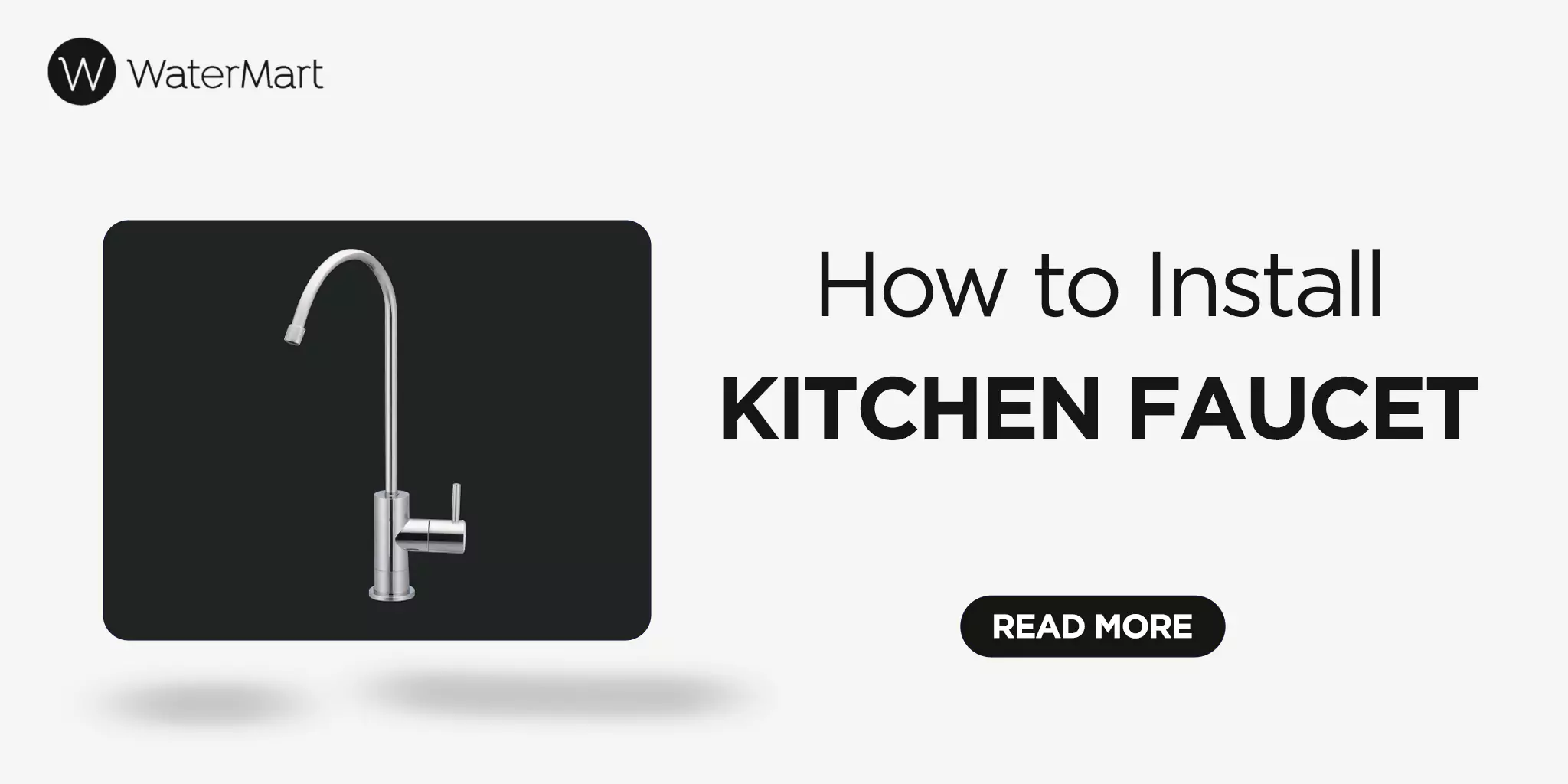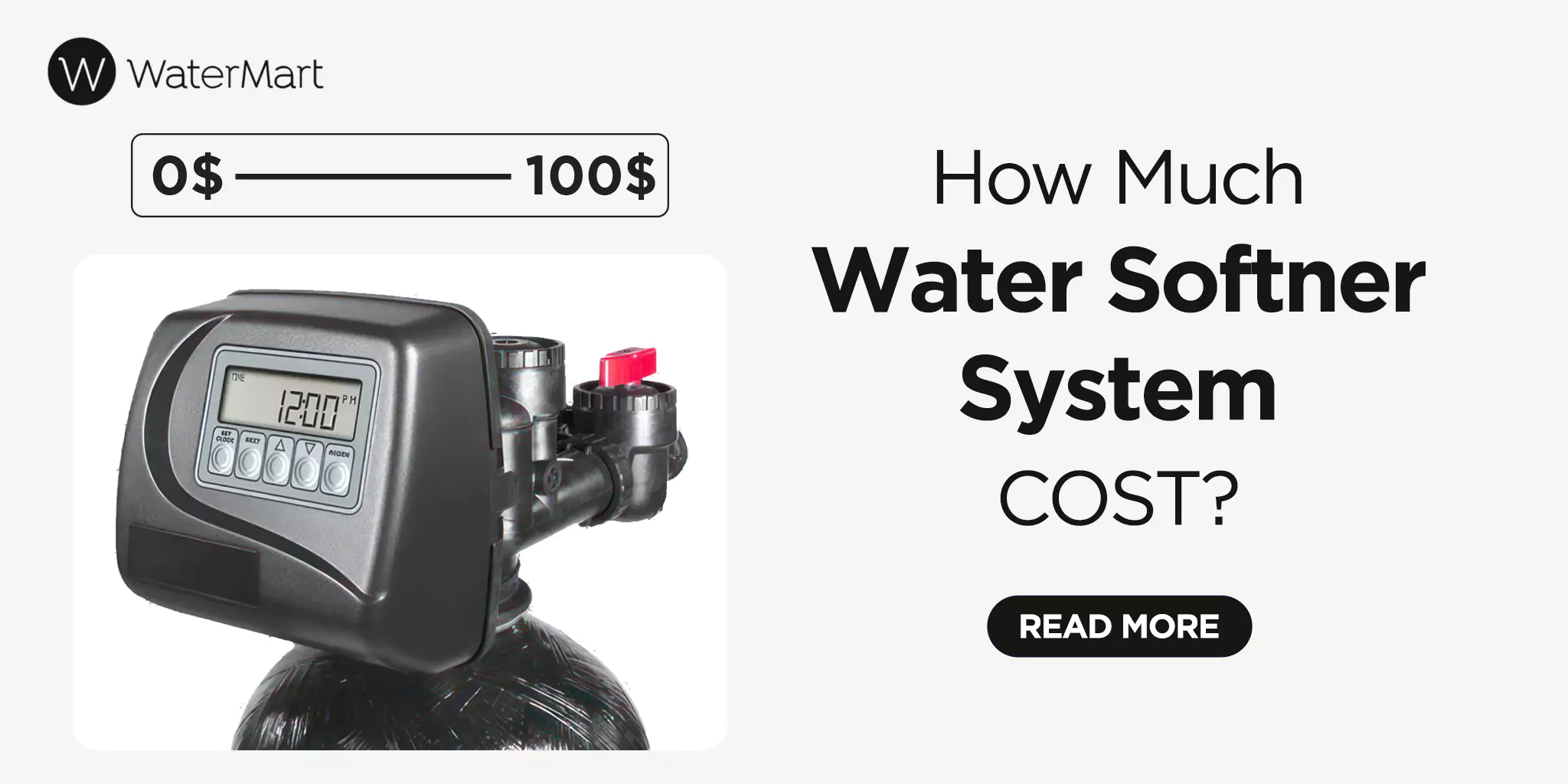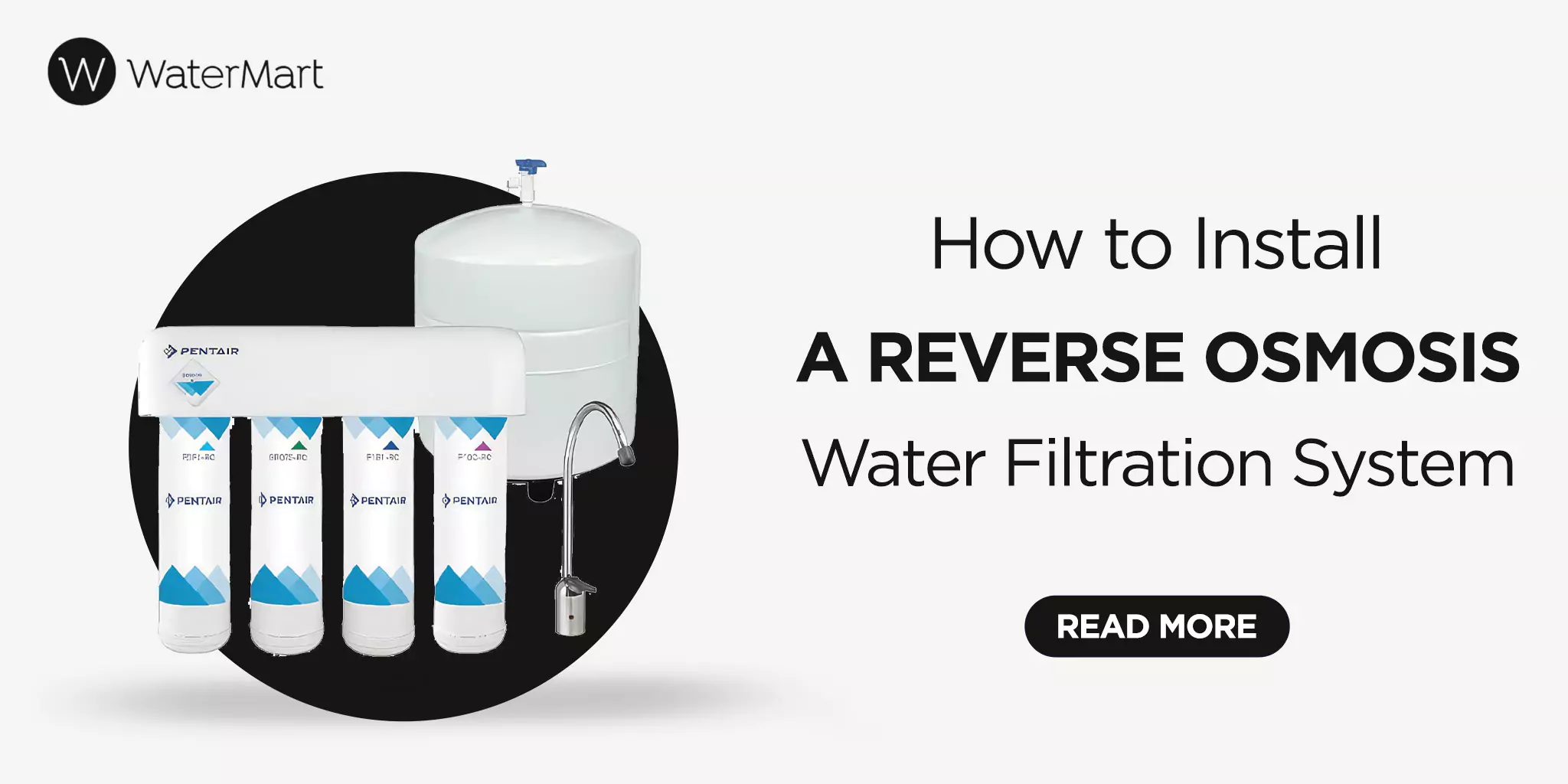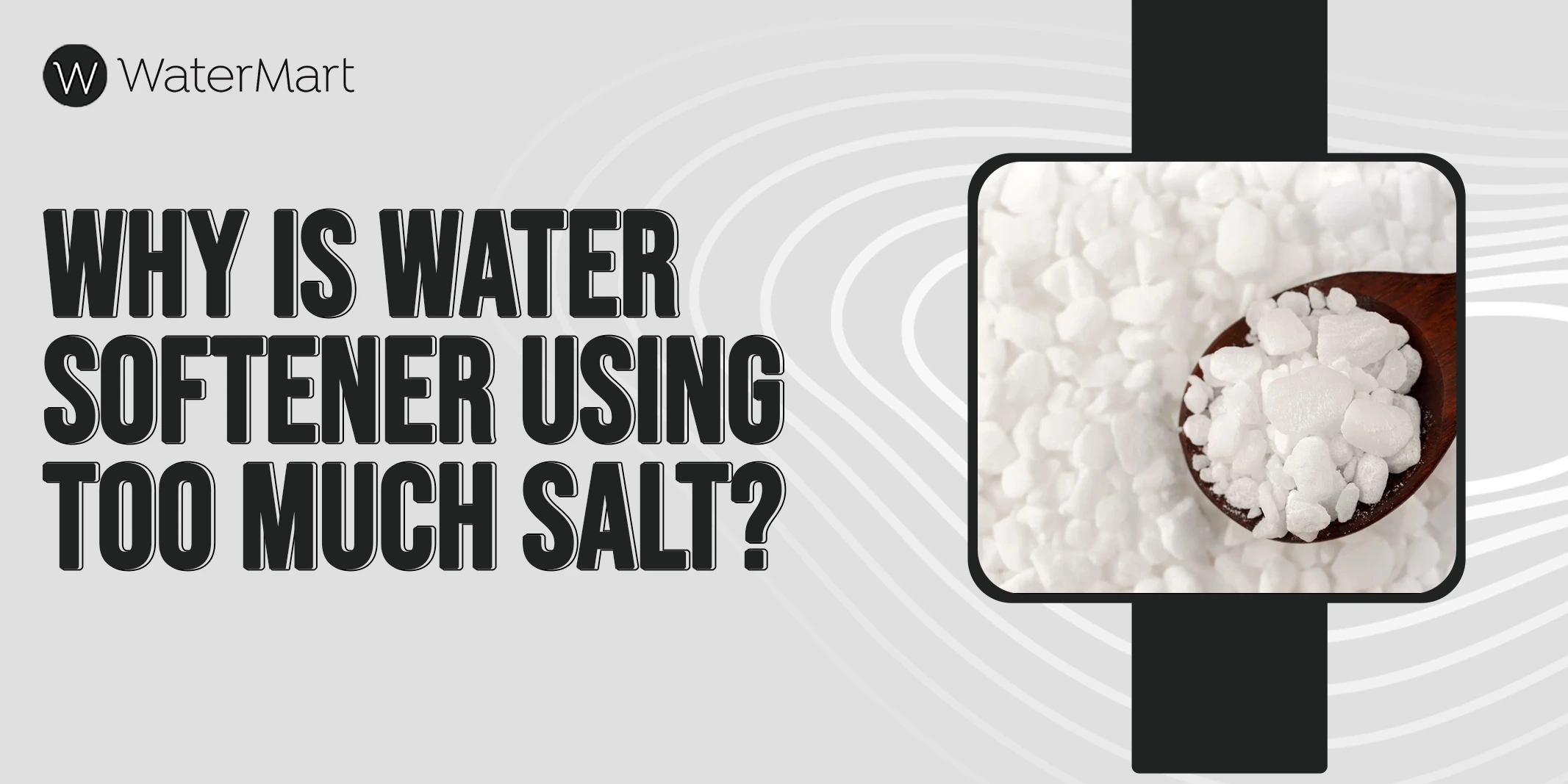Your cart is currently empty!
What Is Water Softener Regeneration – Process And Its Types
In Canada, water softeners are high in demand because they remove hard particles and filter out soft water for home use. A water softener uses an ion exchange method, which uses resin beads to clean the hard minerals from the water.
In return these beads get saturated with hard minerals, the process of removing these minerals and cleaning the beads is known as the regeneration process or REGEN.
The process may seem complex to first-timers and users who have just switched to water softener systems from other filters. That’s why we are here to explain what is water softener regeneration in detail. We will also explore, the step-by-step process, types, the amount of salt used, and its pros and cons. Let’s continue to understand it.
How does a water softener work?
There are many types of impurities in water and hard water is one type that needs a special filtration process. The filters usually installed for hard water are known as water softening systems. These water softeners remove the particles from the water that cause water hardness. These impurities are usually salts of calcium and magnesium.
Now what happens in a water softener is to be understood. A water softener uses resin beads and salts as the main filtration media. When the hard water enters into the water softener, the resin beads entrap the hard particles in them, leaving the soft water as the filtration product.
The whole process is possible because of the ion exchange process. Look at the ion exchange process to understand the whole science of water softener.
Ion Exchange Process:
The ion exchange process is the key to a water softener system. In this, hard water passes through a bed of tiny resin beads, covered in sodium or potassium ions. The resin beads attract the hard minerals, calcium, and magnesium since these minerals have a positive charge. The beads then swap out the sodium or potassium ions with the calcium and magnesium ions.
As a result, the hard minerals stay on the beads, and the water that exits the system is softened. Over time, the beads get saturated with calcium and magnesium, and they need to be cleaned through a regeneration cycle, where saltwater (brine) is used to flush the hard minerals out.
How Does Water Softener Regeneration Work
Water softener regeneration is the process of flushing away the hard minerals using pressure water and brine solution. The regeneration process works when the resin beads are saturated with mineral build-ups and they can’t absorb more of them. It makes the resin beads charged and ready to accumulate new mineral buildups.
Steps Involved In Regeneration Process
Now let’s understand what is the process of regeneration, what steps it involves and what is the science behind each process.
In the water regeneration process, the water beads clean themselves and recharge to continue cleaning the water. The process consists of the following steps:
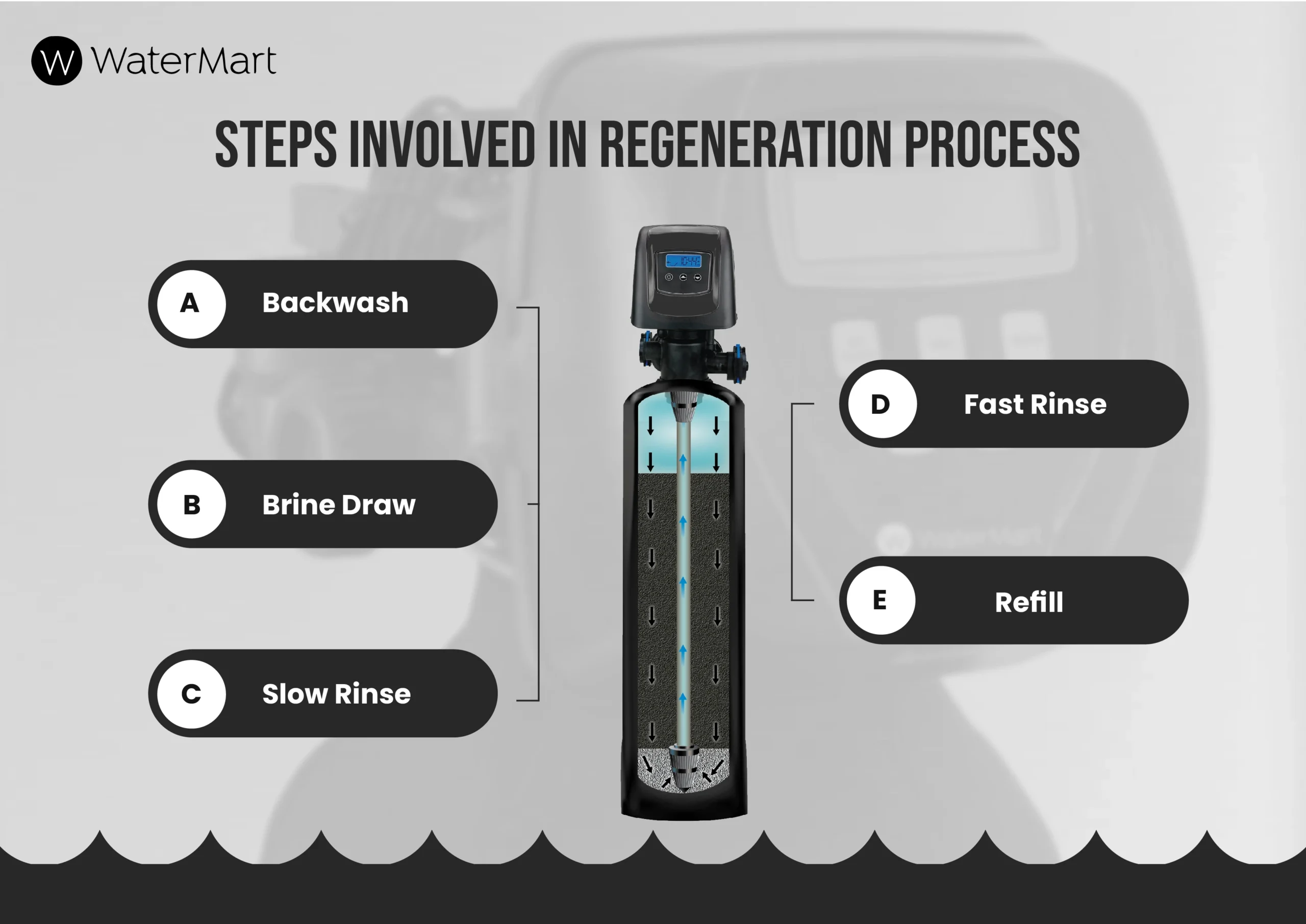
A. Backwash
The first step is backwash. In this ten minutes process, the water flows in reverse direction, to clean the whole filtration system. During backwash, the water pressure is quite high, removing all the dirt, debris, and sediments from the beads helping them loosen the particles for further cleaning.
B. Brine Draw
The next step is the brine draw, the process that introduces a highly rich brine solution to the tank. Here the brine solution contains the sodium or potassium ions that replace the hard minerals from the resin beads. This process takes 50 to 60 minutes. Another ion exchange process takes place at this stage, during which the sodium ions replace the magnesium and calcium ions from the resin beads. The sodium ions recharge the resin beads which play a crucial role in the next water softening batch.
C. Slow Rinse
Water flows through the system after the brine solution is passed. This slow rinse of water pushes the brine to every corner of the beads tank, ensuring that all the beads have been treated with the brine.
D. Fast Rinse
Once the regeneration process is done, a slow rinse is carried out by flowing high-pressure water through the system. This removes all the unwanted mineral pile-ups, if any. It also removes the leftover brine/salt particles from the system to bring salt-free water to your water disposals.
E. Refill
This is the last step in the regeneration process where brine tanks get new water, which is helpful for dissolving salt, to make the brine for the next regeneration cycle.
How Long Does It Take A Water Softener To Regenerate?
The regeneration process takes 90 to 120 minutes per cycle, depending on the size of the water filter and the amount of water it cleans. The backwash stage takes 10 to 15 minutes, the brine wash takes 60 to 80 minutes, and the slow rinse, fast rinse, and refill almost take 5-6 mins each.
Why Do Water Softeners Go Through A Regeneration Cycle?
As you know, water softeners work all the time to remove hard particles from tap water and give you soft and usable water with maintained hardness levels. However, the hard particles and minerals accumulated on the resin beads oversaturate them, so they no longer remove the hard particles from the water.
At this point, softeners have to remove all the mineral build-ups, clean the resin beads, and charge them with sodium ions for further water filtration. For this purpose, regeneration takes place and removes all the hard minerals from the system.
How Much Water Is Needed For Regeneration?
Now, when you install a filtration system, you think of water economy too. How much water is required for the regeneration process surely depends upon the capacity of your water softener and the amount of hardness of your water. On average, a water softener uses motive water three times more than concentrated brine.
Let’s say your brine tank capacity is 10 to 20 gallons, the amount of water used will be around 35 to 65 gallons.
Break Down Of Water Usage During Regeneration Process:
If you are using an average of the older model, your water softener will use water in the following amounts:
- Backwash Stage:
It uses 15 – 20 gallons. This process eliminates all the dirt and debris collected during the softening process, so needs a higher volume of water. - Brine Draw and Slow Rinse
This process takes up most of the water volume. It uses 15 -30 gallons to ensure that beads are fastly tightened together, washed completely, and have exchanged the sodium ions while removing hard minerals from them. - Fast Rinse
This is the final washing stage which uses high-pressure water volumes to remove the residual salt and minerals from the system, taking up 10 to 15 gallons of water.
At watermart, water softener systems are designed with maximum salt and water efficiency. They add up the minimum cost of salt and water to your bill. If you contact us today, our experts can completely guide you and offer you the best models with the latest technology and maximum efficiency.
Different Kinds Of Water Softener Regeneration Cycles
In new models, regeneration processes are customizable and you can choose any depending on your convenience and availability.
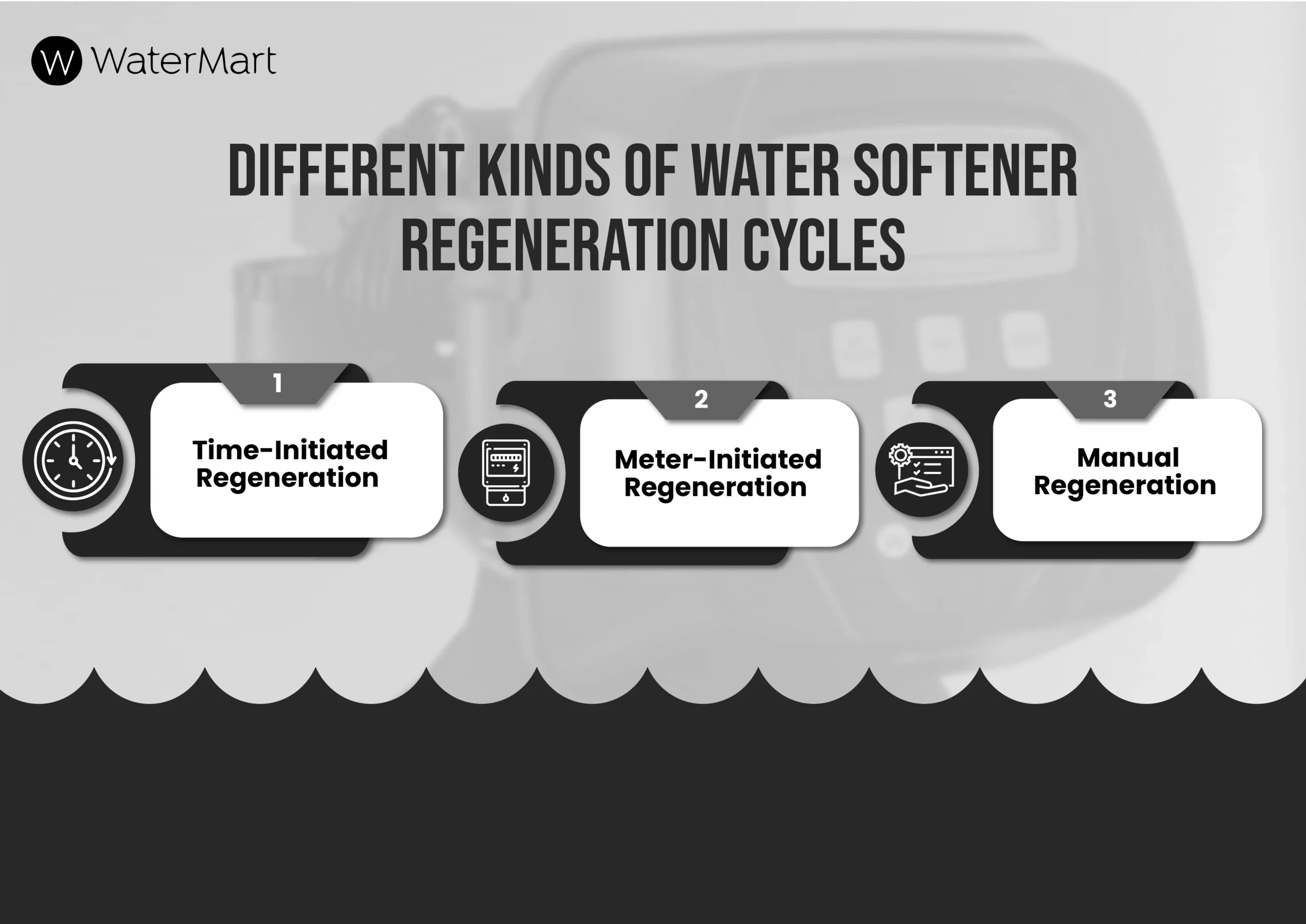
- Time-initiated regeneration
In this regeneration, the system is set for a certain time period, let’s say 48 hours. So as soon as the time reaches, the regeneration starts automatically. It is a good approach but at times, even if the regeneration isn’t required, the system is forced to do the regeneration, resulting in a waste of salt and water. - Meter-initiated regeneration
In meter-initiated regeneration, the controls are set at a certain amount of water softened before the process starts. As soon as the system softens that amount of water, it starts regeneration. This is the most economic regeneration process as it starts when the beads have delivered the required amount of soft water and need to be cleaned before the next softening process. - Manual regeneration
In these water softeners, manual controls are used to start the process. When the analog meters show a certain time has passed and the softener has cleansed the threshold amount of water, the filter owners start the regeneration manually. This process is on demand and needs a manual inspection of the beads and the meter readings before you start the regeneration process.
Factors That Influence How Often Regeneration Is Needed
How often your water softener should regenerate? The simple answer to this question is how often the beads are saturated with hard minerals. You need to clean and regenerate the beads as often as they accumulate the hard minerals in them normally the frequency of the regeneration process depends on the following factors.
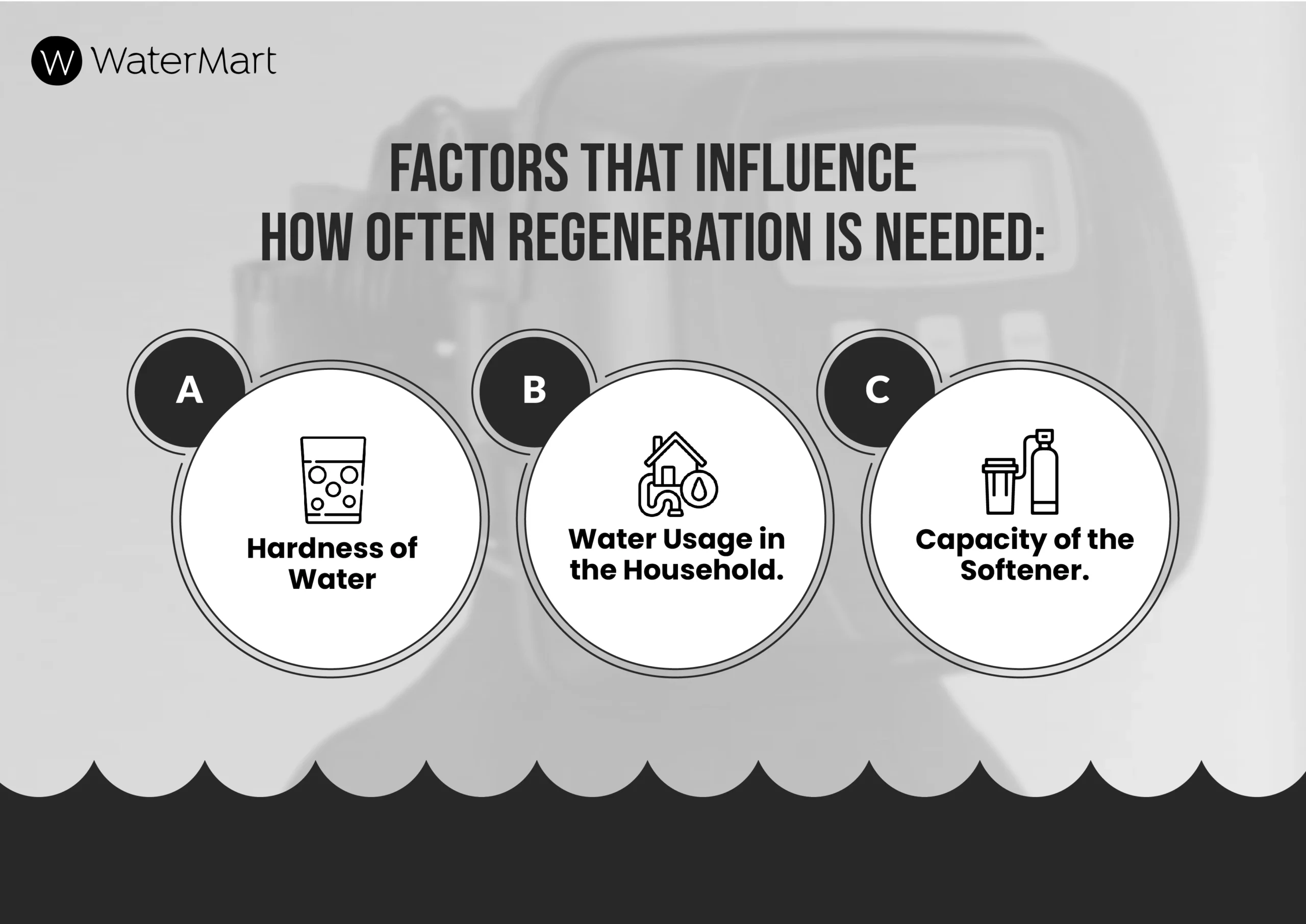
- Hardness of water
If your water hardness is high, the resin beads remove a large amount of hard minerals to soften the water. As these minerals pile up the beads, a regeneration process is required to clean and recharge the beads. - Water usage in the household
The frequency also depends upon the amount of water used in your household. In simple words, if you are on vacation, and have not used water at home, your system will not need any regeneration until it softens the amount of water. The same goes for excessive use of water, if you use a higher amount of water, regeneration is required more frequently. - Capacity of the softener
The capacity of a water softener is the amount of grains it cleans or softens every time it works. If you are using water more than the capacity, it needs frequent regeneration and vice versa.
Salt Usage in Regeneration
The amount of salt needed for every regeneration process is dependent on a few factors.
- Capacity of water softener
- The hardness level of water
- Amount of water being softened during each cycle
- Salt settings and their efficiency
As a simple rule of thumb, the more water usage, the higher the salt requirement. The amount of water softened is directly proportional to the amount of salt required for cleaning and regenerating the beads.
Usually, normal house water softeners need 5-6 pounds of salt per cycle, but you can increase the salt efficiency and decrease the usage by choosing low salt settings on your system. But in case your water hardness levels are higher, you need higher amounts of salt.
How To Stop Water Softener Regeneration
- For troubleshooting, you need to understand a few things about the regeneration process or how to stop it. If you spot a leak, unusual sound, or broken part inside the softener, the regeneration should be stopped immediately. Otherwise, you may incur higher repair costs, salt costs, and water bills. Here are some steps you can follow to stop regeneration.
- By unplugging the water softener you can stop the process immediately.
- By using the bypass valve it does not let water enter into the water softener and thus the regeneration does not occur.
- Use the digital control system if you are using a newer model water softener. Choose the cancel or pause button to stop the process.
- Check the manual, see the instructions, and follow them to stop the process. It is only possible if you have the manual of your water softener.
In case, you don’t have an emergency and don’t find an option to stop the regeneration process, simply wait until the regeneration completes. Then switch off the whole system. This is usually workable if you are going on a vacation or need thorough maintenance. Otherwise stopping the process during regeneration is not recommended.
Common Problems with Water Softener Regeneration and how to fix them
If you feel your water hardness level is still high after the softening process or you get salt in the water, it is an indication that the regeneration is not properly done. Your water softener regeneration process may be having the following problems.
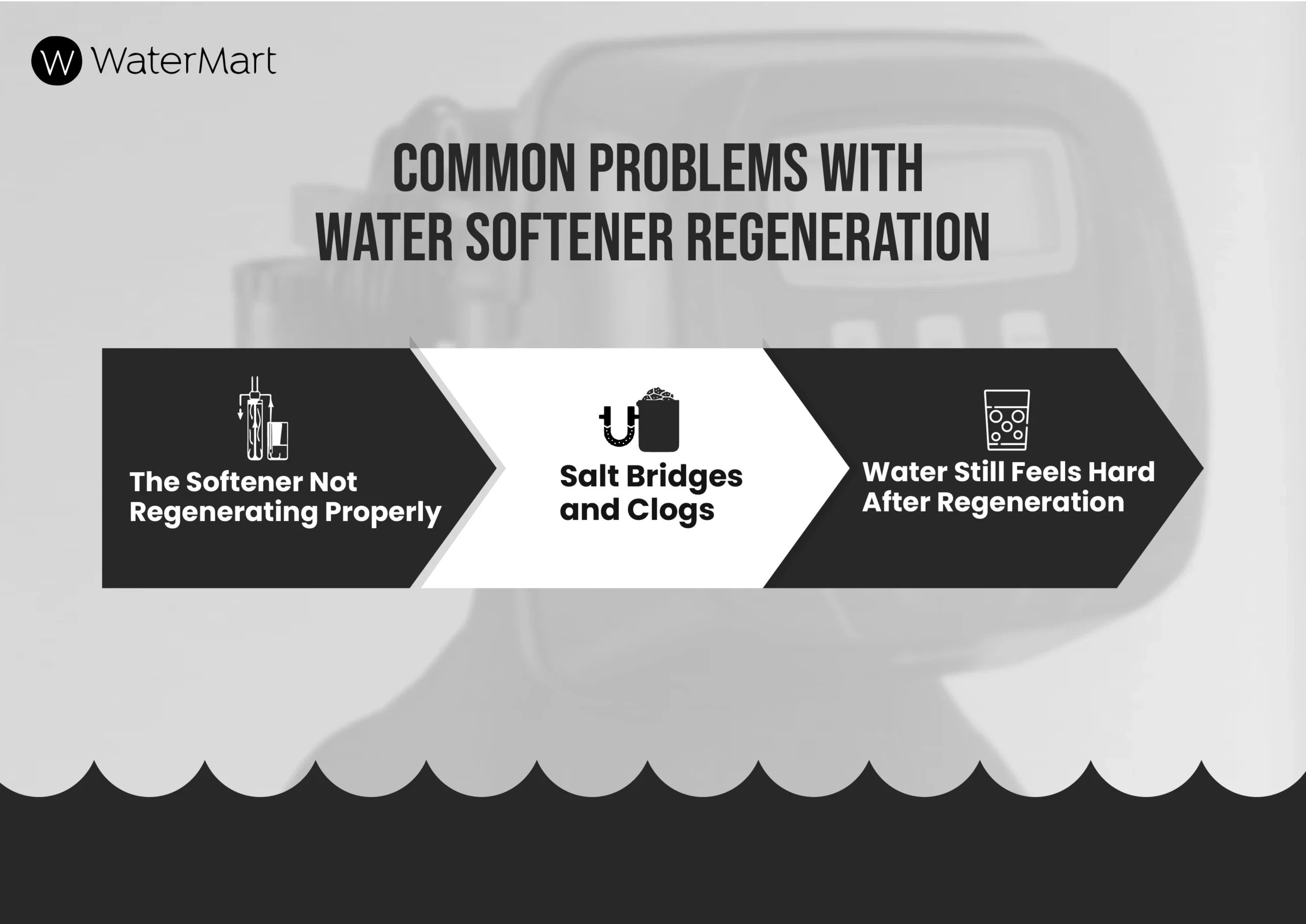
- The softener not regenerating properly
There could be several reasons for that you need to check for all manually. The reasons may include improper functioning of the bypass valve, improper programming, or any broken jigs and fixtures. Check your system for these issues one by one, and fix them if spotted. - Salt bridges and clogs
Over time, salt clogs and bridges appear in the brine tank. You can figure them out in case you see salt pile-ups at the surface (known as salt bridges) or salt deposits at the bottom (known as salt clogs or mushing ). In both cases, salt does not take part in the regeneration process and either recrystallizes at the bottom or oxidizes at the top. You can remove the bridges and clogs from the system by manual cleanliness and flushing a high volume of water for complete removal. - Water still feels hard after regeneration
This is due to the inefficiency of the regeneration process. It might happen because of low salt settings or high water consumption. Look for both reasons and fix them accordingly.
Final Thoughts On Water Softener Regeneration
Water softener regeneration is important for the maintenance of your filtration system. It increases the lifespan of your system and the beads, otherwise, your beads may deteriorate because of the dirt, debris, and mineral build-ups. In simple words, every hard mineral it removes from the water is accumulated on the beads’ surface which should be flushed away and replaced by sodium ions for the next cycle of water softening. This process of cleaning and renewing beads is known as the regeneration of REGEN.
The process is based ion exchange method, along with water and brine solution, and is automated mostly. A close look at the water softening system can save your salt and water bills. But in case your water softener is using too much salt, or needs thorough maintenance, you can call us at watermart, to get expert help.
Frequently Asked Questions
Can I drink water while the water softener is regenerating?
During the regeneration process, water is hard, so if you drink water during that period, you will end up getting hard water. That’s why experts don’t recommend drinking water during the regeneration process.
What happens if you don’t regenerate your water softener?
The system stops filtering the hard minerals because the resin beads don’t have any space to accumulate hard minerals on them. So it results in getting the hard water again until you regenerate the resin beads.
How do I know if my softener is regenerating?
Every water softener has different programming. As a general rule, there are different timers that show you when it is time for regeneration, and you can also get this indication from the control panels. The regeneration process is usually set at night when the household requires the least water for use.
What happens if you shower while the water softener is regenerating?
Showering during the regeneration process gives you hard water, that may impair your heating elements if you are using hot water for the shower. Apparently it may or may not bother you, but it can reduce the lifespan of your water heaters.
Can I change the time my water softener regenerates?
Yes, though the regeneration time is pre-set in the factory, you can re-set it at home especially if you are using new models of water softeners. Go to the control panel, choose settings, find the time and day buttons, choose the cycle start time, and set it while selecting A.M or P.M, after that save the settings or confirm it by pressing the relevant buttons, based on your softener model.
Can you hear a water softener regenerating?
Yes, the regeneration process involves high-pressure water that flushes to and fro many times to clean the beads. In case you hear some sounds like gurgling, clicking, or clunking.
